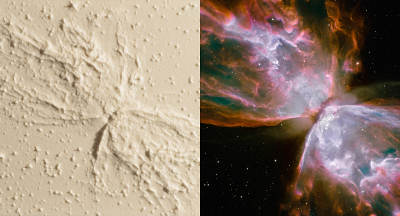Communications of the ACM
Program to Improve STEM Access For Blind, Visually-Impaired Students

ASU senior Ashleigh Gonzales tests new 3-D tactile boards that will be used in basic STEM courses. Gonzales, who is blind, is part of an ASU research team developing the materials.
Credit: Jacob Mayfield / Arizona State University
Arizona State University is kicking off a pilot program aimed at improving access to science, technology, engineering, and math (STEM) classes for students who are blind or visually impaired.
Called 3D-Imagine (Image Arrays to Graphically Implement New Education), the program will use three-dimensional materials to enhance independent learning. Researchers are seeking as many program participants as possible from both ASU and the wider community.
Introductory Biology 100 and Astronomy 113 lab classes each will have one section using new, 3-D tactile boards designed specifically for students who are blind or visually impaired. However, sighted students may use the materials as well.
"Textbook images typically contain important messages, whether it's intensity or altitude, or cell structure," says Rogier Windhorst, Regents' and Foundation Professor in ASU's School of Earth & Space Exploration. "We think these messages can be conveyed in a 3-D tactile just fine. While a person who is blind would have to sense the information, we believe 3-D images may open up a new world in STEM courses for students who are visually impaired."
To test their theory, an ASU interdisciplinary research team developed a series of 3-D tactile boards that represent key textbook images. Students need to understand these images in order to successfully complete each science class. Made of high-density plastic, the boards will initially cost about $60 each, and be used in place of or in addition to traditional lab materials.
 The image on the left is created on a 3-D tactile board. It corresponds to the original Hubble Space Telescope Butterfly Nebula image. The 3-D image is carved out of a high-density plastic, and provides greater image information to students who are blind or visually impaired. The image on the left is created on a 3-D tactile board. It corresponds to the original Hubble Space Telescope Butterfly Nebula image. The 3-D image is carved out of a high-density plastic, and provides greater image information to students who are blind or visually impaired.Credit: Arizona State University (left) / Hubble Space Telescope (right)
|
The goal is to provide an opportunity for students who are blind or visually impaired, to learn the material independently.
College-level STEM courses are typically rigorous, but for blind or visually-impaired students, these classes often present even greater challenges. Imagine taking an astronomy class and having to depend on someone else to accurately and effectively describe a photo of a nebula, or in biology, detail the image of a cell.
The idea to turn digital images into 3-D tactile representations originated in Debra Baluch's upper-level Cell Biotechnology class. Baluch, a research scientist in ASU's School of Life Sciences, in the College of Liberal Arts and Sciences, taught junior Ashleigh Gonzales last spring. Gonzales is pursing a degree in molecular biosciences and biotechnology, and is visually impaired.
"She is just as capable as anyone else in the class of doing this level of science, but unfortunately, she faces a barrier," Baluch says. "What she chooses as a career may be decided by her visual impairment, even though she has the same level of education as her peers. We can improve access to our STEM classes by providing these 3-D models which we expect will enhance independent learning in students who are visually impaired."
"Accessible is an interesting term," says Terri Hedgpeth, director of ASU's Disability Resource Center. "When a student signs up for a class, we get the textbook and convert it into Braille or electronic text, and we render tactile diagrams that go along with it. That's time-consuming and expensive," she adds. "What we are doing in this pilot program allows us to create 3-D models which provide a better tactile representation of the material. It's very different from the line pictures we typically produce."
If the pilot program is successful, the team hopes to lay the foundation for using the 3-D tactile boards in all 100-level STEM courses. The team includes researchers from ASU's School of Life Sciences, School of Earth & Space Exploration, Ira A. Fulton Schools of Engineering, and Disability Resource Center. The group is currently seeking funding from the U.S. National Science Foundation and other organizations to support the program.
"I would like to see students be inspired to take additional classes in STEM and consider majors in the STEM fields," Hedgpeth says. "Maybe we can excite them a bit and raise their hopes for a better level of access."
No entries found